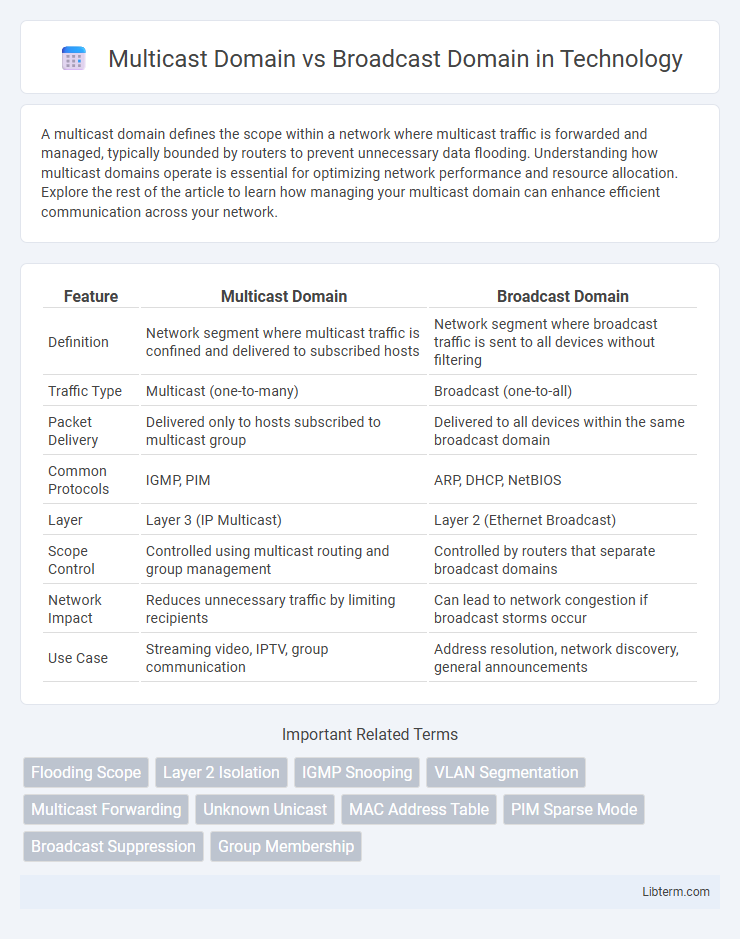A multicast domain defines the scope within a network where multicast traffic is forwarded and managed, typically bounded by routers to prevent unnecessary data flooding. Understanding how multicast domains operate is essential for optimizing network performance and resource allocation. Explore the rest of the article to learn how managing your multicast domain can enhance efficient communication across your network.
Table of Comparison
| Feature | Multicast Domain | Broadcast Domain |
|---|---|---|
| Definition | Network segment where multicast traffic is confined and delivered to subscribed hosts | Network segment where broadcast traffic is sent to all devices without filtering |
| Traffic Type | Multicast (one-to-many) | Broadcast (one-to-all) |
| Packet Delivery | Delivered only to hosts subscribed to multicast group | Delivered to all devices within the same broadcast domain |
| Common Protocols | IGMP, PIM | ARP, DHCP, NetBIOS |
| Layer | Layer 3 (IP Multicast) | Layer 2 (Ethernet Broadcast) |
| Scope Control | Controlled using multicast routing and group management | Controlled by routers that separate broadcast domains |
| Network Impact | Reduces unnecessary traffic by limiting recipients | Can lead to network congestion if broadcast storms occur |
| Use Case | Streaming video, IPTV, group communication | Address resolution, network discovery, general announcements |
Introduction to Network Domains
A multicast domain is a network segment where multicast traffic is forwarded to all devices interested in receiving specific group messages, optimizing bandwidth by targeting only designated hosts. In contrast, a broadcast domain includes all devices that receive broadcast frames sent by any device within the same segment, often leading to higher network congestion due to indiscriminate traffic delivery. Network segmentation techniques such as VLANs and routers help contain broadcast domains, while multicast routing protocols like PIM manage multicast domains to enhance network efficiency.
What is a Broadcast Domain?
A broadcast domain is a network segment where a broadcast frame sent by any device is received by all other devices within the same segment, typically bounded by routers. It defines the scope in which broadcast traffic, such as ARP requests or DHCP offers, is propagated without being filtered. Maintaining a clear broadcast domain helps reduce unnecessary traffic and improves network efficiency by limiting broadcast storms.
Defining Multicast Domain
A multicast domain is a network segment where multicast traffic is allowed and managed, enabling efficient one-to-many communication within a specified range of devices. It is defined by the scope of multicast group membership and routing protocols like IGMP and PIM, which control multicast packet delivery without flooding all nodes. Multicast domains differ from broadcast domains by limiting traffic only to subscribed hosts, reducing unnecessary network load and optimizing bandwidth usage.
Key Differences Between Broadcast and Multicast Domains
Broadcast domains encompass all devices that receive broadcast frames sent by a single device, causing potential network congestion and security concerns due to unnecessary traffic. Multicast domains limit traffic to specific groups of interested devices using multicast MAC addresses, enhancing network efficiency by reducing redundant data transmission. Unlike broadcast domains, multicast domains enable scalable communication in applications such as IPTV, video conferencing, and live streaming by targeting selective recipients rather than all nodes.
How Broadcast Domains Work in Networks
Broadcast domains define network segments where a broadcast frame sent by any device is received by all other devices in the same domain, typically bounded by routers or VLANs. Devices within a broadcast domain share the same Layer 2 network and broadcast traffic, which can lead to network congestion if the domain is too large. Effective network design segments broadcast domains using routers or VLANs to limit broadcast traffic and improve overall network performance.
How Multicast Domains Operate
Multicast domains operate by grouping devices that subscribe to specific multicast groups, allowing efficient delivery of data only to those interested receivers rather than all devices in the network. Multicast traffic is managed using Internet Group Management Protocol (IGMP) for IPv4 or Multicast Listener Discovery (MLD) for IPv6, ensuring devices dynamically join or leave multicast groups. Network switches use multicast forwarding tables and protocols like Protocol Independent Multicast (PIM) to control traffic flow within multicast domains, reducing unnecessary load compared to broadcast domains where data is sent to all devices.
Advantages of Broadcast Domains
Broadcast domains enable efficient communication within network segments by limiting broadcast traffic, which reduces unnecessary data transmission and enhances overall network performance. Segmenting a large network into smaller broadcast domains improves security and reduces collision domains, leading to faster data transfer and minimized latency. Devices within a broadcast domain can efficiently discover each other through broadcast messages, simplifying network management and device interaction.
Benefits of Multicast Domains
Multicast domains enable efficient data distribution by restricting traffic to only interested receivers, reducing unnecessary network load compared to broadcast domains that send packets to all devices. This targeted delivery optimizes bandwidth utilization and enhances network performance, especially in large-scale environments with multiple group members. Multicast domains also improve scalability and security by isolating traffic to specific segments, minimizing broadcast storms and potential network congestion.
Use Cases for Broadcast vs Multicast Domains
Broadcast domains efficiently deliver network traffic to all devices within a specific segment, making them ideal for small networks requiring service announcements and address resolution protocols like ARP. Multicast domains optimize bandwidth by sending data to multiple receivers interested in specific streams, such as video conferencing, IPTV, and real-time stock trading, without overwhelming all network devices. Broadcast domains are commonly used for local network discovery and communication, whereas multicast domains support scalable distribution of multimedia content and group communications in enterprise and service provider environments.
Choosing the Right Domain for Your Network
Selecting the appropriate domain for your network depends on traffic patterns and scalability requirements. Multicast domains efficiently deliver data to multiple specific devices using IGMP, minimizing bandwidth usage in IPTV and conferencing applications. Broadcast domains, limited by routers, are ideal for small, flat networks needing widespread device discovery but can cause congestion in larger environments.
Multicast Domain Infographic

 libterm.com
libterm.com